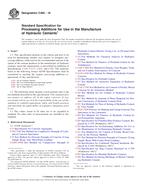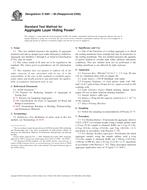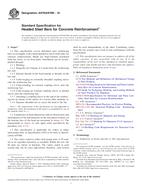1.1 This test method describes a laboratory test for determining the resistance of metallic materials to metal-to-metal wear produced in a crossed cylinder apparatus. The intent of this test method is to produce data that will reproducibly rank materials in their resistance to wear and evaluate the compatibility of different metal couples. The test method is normally used to determine the wear resistance of a material when it wears against itself. However, the test can also be used to evaluate the compatibility of different materials.
1.2 When the rotating and stationary bars are of the same material, wear test results are reported as the total volume loss in cubic millimetres for the rotating and stationary cylinders. The manner of recording the results also specifies the particular test procedure used. The value is obtained by adding the volume loss of the rotating member to the volume loss of the nonrotating member. Materials of higher wear resistance will have lower volume loss.
Note 1-To attain uniformity among laboratories, it is the intent of this test method to require that volume loss due to wear be reported only in the metric system as cubic millimetres (1 mm = 6.102 X 10 in. ).
1.3 When dissimilar materials are being tested, wear test results are reported as the volume loss in cubic millimetres for the rotating and stationary test bars separately. When two different metals or alloys are tested, it is also recommended that each metal or alloy be tested in both the stationary and moving positions. Then, for each metal or alloy, the combined volume of wear in both positions should be used in comparisons with self-mated wear volume.
1.4 The test method describes three recommended procedures that are appropriate for different degrees of wear resistance.
Note 2-The crossed cylinder wear test inherently exhibits a time varying contact area. A plot of wear volume versus sliding distance is typically nonlinear. Therefore, results obtained using parameters other than those specified in the test method cannot be used to calculate an expected value.
1.4.1 Procedure A -This is a relatively severe test that will rank metallic materials which have high-wear resistance. Materials with wear resistance in the high-speed tool steel category are particularly suited to this test.
1.4.2 Procedure B -This is a short-term variation of Procedure A.
1.4.3 Procedure C -This is a lower speed and shorter term variation of Procedure A that is particularly useful in ranking materials of low-wear resistance.
1.5 In reporting, the values stated in SI units are preferred.
1.6 This standard does not purport to address all of the safety concerns, if any, associated with its use. It is the responsibility of the user of this standard to establish appropriate safety and health practices and determine the applicability of regulatory limitations prior to use.
Product Details
- Published:
- 11/10/1996
- Number of Pages:
- 6
- File Size:
- 1 file , 130 KB


